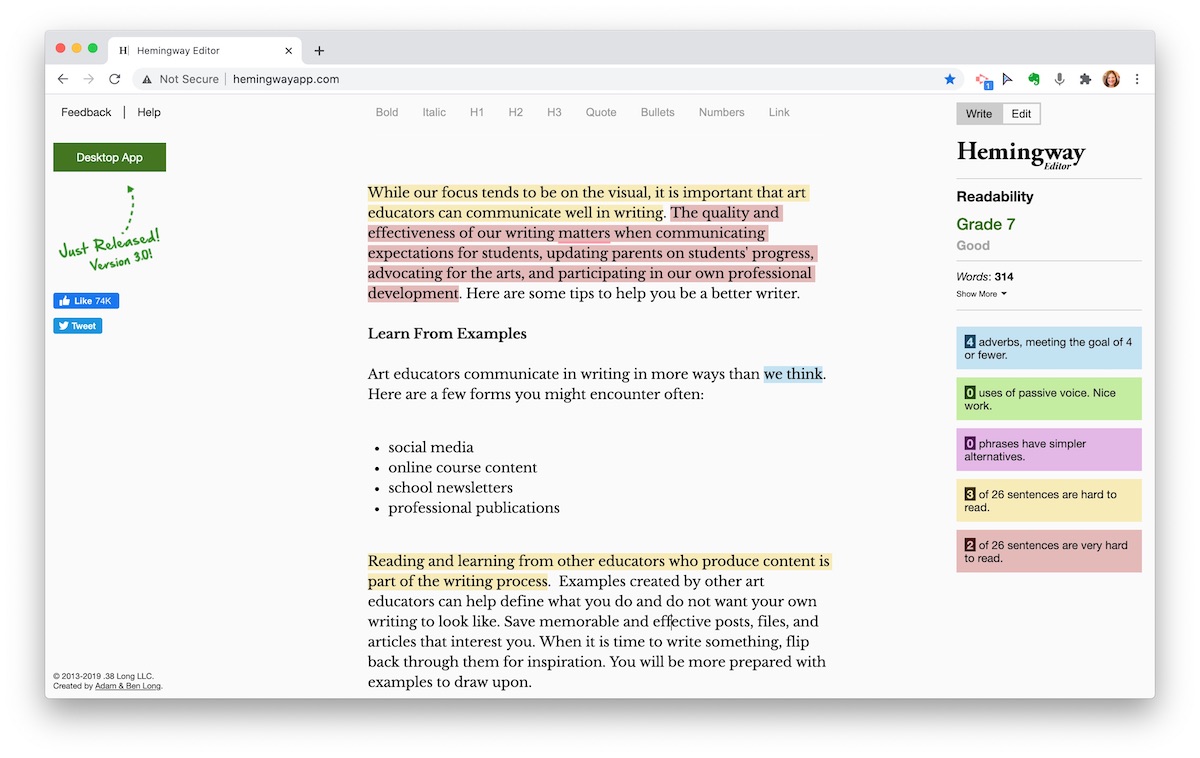While our focus tends to be on the visual, art educators also need to effectively communicate in writing. The quality of our writing matters when it comes to expectations for students, updating parents on students’ progress, advocating for the arts, and participating in our own professional development.
Here are 11 tips for improving your writing:

1. Learn from examples.
Art educators communicate in writing in more ways than we think. Here are a few forms you might encounter often:
- Social media
- Online course content
- School newsletters
- Professional publications
Reading and learning from other content producing educators is part of the writing process. Examples created by other art educators can help define your own writing style. Save memorable and effective posts, files, and articles that interest you. When it is time to write something, flip back through them for inspiration. You will be more prepared with examples to draw upon.
2. Freewrite and revise.
Widely cited experts on writing, such as Peter Roy Clark and Anne Lamott, suggest beginning with freewriting when you sit down to write. Just as most people would find it ill-advised to obsess over details in one tiny area at the start of a drawing or painting, overthinking single sentences early on makes it difficult to find a flow and develop stories or arguments in writing.

Instead, try this:
- Write a “brain dump.” For example, write the first draft of a parent or principal email and then set it aside for a bit.
- Revisit your work. Are there areas where you need to elaborate on concepts or refine your wording?
- Peer-review. Have someone check your writing for clarity and messaging. Can a peer identify your main points? Do they feel your writing is well organized?
3. Consider your image.
When writing, art teachers have the power to frame their program and art education positively. To ensure your writing is taken seriously:
- Spellcheck. Use correct grammar and spelling. Avoid the use of internet slang.
- Use exclamation points wisely. Remember, the way you use punctuation can communicate a professional tone. Save exclamation points for when you truly need to emphasize a statement.
- Consider the audience. Put yourself in the reader’s shoes. How will they perceive this information from their point of view?
4. Try Grammarly and Hemingway Editor.
Grammarly and Hemmingway Editor are two apps useful for improving the clarity and quality of your writing. Both apps offer free access at the basic level. Grammarly supports writing online and within a Learning Management System (LMS). It identifies spelling, grammar, and punctuation errors. It can also offer feedback on the tone of your writing.

Hemingway Editor identifies difficult to read statements, grade-level readability, and statements that appear in the passive voice. For example, Hemingway Editor will highlight a statement like, “The bowls have been glazed by the students,” as a statement in the passive voice. While this app will not provide you with an immediate fix, it will help you to recognize repeated areas you can focus on for improvement. In this case, simply rewriting the sentence in the active voice, “The students glazed the bowls…,” will solve the problem and strengthen your writing.
5. Avoid generalizations.
One writing mistake editing apps may not catch is the use of generalizations. Generalizations are broad statements that sound true in all cases, but they may not be in reality. “All” and “always” are common indicators of generalizations. These terms can be implied, too. For example, “Art unleashes student creativity” is a generalization. Statements like this should be supported with evidence or avoided in writing.
6. Avoid mixed metaphors.
Another writing mistake editing apps may not recognize is the use of mixed metaphors. Mixed metaphors happen when we use more than one comparison over the course of writing.

For example, you could liken teaching to both gardening and building. Your writing will be stronger, though, if it follows just one of those metaphors throughout the duration of an article, paper, or post.
7. Avoid deficit thinking.
As you review your writing, consider whether your statements focus on deficits or reflect an asset-based approach. Deficit models limit student outcomes and disproportionately affect minority students. Teachers who use deficit thinking usually do not realize they are doing so, but it becomes evident through word choice. For example, stating, “Students do not take art seriously,” represents deficit thinking. Instead, rephrase this idea to become, “Students can reach their full potential when they take art seriously.”
8. Embrace an asset-based approach.
You can positively frame your program and art education by using an asset-based approach when describing your students and the community in which you teach. An asset-based approach to teaching focuses on students’ strengths and uses them to address areas of need. It is an aspect of Culturally Responsive Teaching. Stating, “Student artists are most engaged when they choose the topic,” represents an asset-based approach.
9. Use Ethical Practices
It is important to be aware of and follow ethical writing practices. This includes citing sources and seeking permission to include images of artworks with your writing. Not only will this support your credibility, but ethical practices in your writing also set a standard and become a model for students to follow in their writing practice.
10. Give credit.
When you draw upon ideas from other art educators and write about them, give appropriate credit. The field of art education generally follows APA style for papers and manuscripts. The Publication Manual of the American Psychological Association, Seventh Edition (2020) and online resources offer guidance on properly citing many different types of sources, including personal communications, YouTube videos, and blog posts. For informal and online writing, such as this magazine article, hyperlinks to sources are generally accepted.
11. Secure permission for images.
If you would like to include images of artwork with your writing and plan to share with others, make sure you have permission. Student artwork is often covered for local use through a school’s photo release policy. A school photo release policy may not cover blog posts or conference presentations.
If you are not familiar with your school’s policy or do not know who has opted out, writing is a great reason to check! Professional publications may require the use of their own forms for permission to reproduce and distribute an image.
It’s called the art of writing for a reason. Taking time to revise, edit, and improve your writing skills can go a long way! Whether it’s a brief post on social media showcasing student work, an informational newsletter to communicate with adults at home, or a blog post promoting your upcoming art show, following these tips can help polish your writing and put the best version of yourself out there.
What are your strengths as a writer?
How would you like to improve your writing?
Which one of the above tips could you use the next time you write something for your students? Your school community? Your colleagues?
Magazine articles and podcasts are opinions of professional education contributors and do not necessarily represent the position of the Art of Education University (AOEU) or its academic offerings. Contributors use terms in the way they are most often talked about in the scope of their educational experiences.





